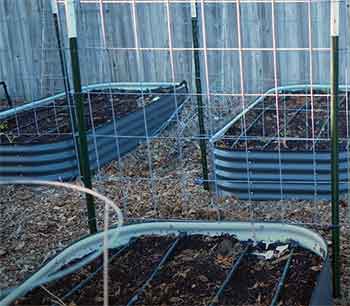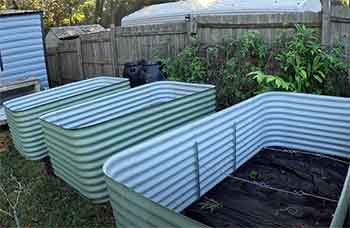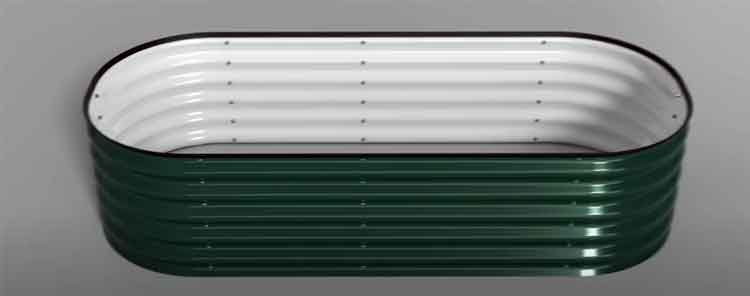I remember when I first considered adding a raised garden bed to my yard. I wanted something sturdy, attractive, and long-lasting. After hearing so much about Vego and Birdies, I decided it was time to figure out which brand suited my needs.
In this article, I’m sharing my personal observations, comparisons, pros and cons, and what I learned from using Vego and Birdies raised garden beds. By the end, you’ll have a clearer idea of which option might work better for you and your gardening goals.
| Feature | Vego | Birdies |
| Material | Aluzinc steel | Aluzinc steel |
| Thickness of Panels | Typically around 0.6mm | Typically around 0.6mm to 0.7mm |
| Aesthetic Options | Neutral colors (e.g., gray, cream) | Wide color range (greens, blacks) |
| Shapes and Sizes | Rectangles, modular configurations | Rectangles, modular configurations |
| Assembly Difficulty | Moderate (requires basic tools) | Moderate (requires basic tools) |
| Price Range | Generally mid-to-high range | Mid-to-high range |
| Availability | Primarily online | Both online and in some retail shops |
| Warranty | Often includes multi-year warranty | Often includes multi-year warranty |
| Popularity Among Gardeners | Growing rapidly in popularity | Established brand recognition |
Key Differences Between Vego And Birdies Garden Beds
Now that we have a rough overview, let’s explore what makes each brand special, figure out the pros and cons, and get into the more details. With that, I want to help you come out with a sense of which raised bed would support your gardening goals in the long run.
- Materials And Construction

As I considered which raised bed to put in my backyard, I found that both Vego and Birdies often use similar high-quality metals.
They typically rely on Aluzinc (or Zincalume) coated steel, which is a steel base coated with a combination of aluminum and zinc.
This coating helps prevent rust and extends the life of the bed.
In my experience, this type of steel can withstand different climates, from scorching summers to chilly winters, without warping or corroding prematurely.
Between the two, the differences come down to panel thickness, finish quality, and sometimes the small components that hold everything together. While some Birdies beds may have panels slightly thicker than Vego’s or vice versa, both brands are generally considered sturdy.
I’d say that for the everyday gardener, the quality is roughly on par: you’ll get something that can last several seasons, if not longer.
Something else I noticed is that the edges on both brands are rolled or well-finished. This means less risk of cutting yourself on a sharp metal edge. From a user standpoint, that’s a huge plus—nobody wants to worry about safety hazards when setting up or tending a garden.
- Assembly And Setup
When I set up my first raised garden bed, I learned that assembly can be either a breeze or a headache depending on the product. Both Vego and Birdies arrive as flat-pack systems.
You receive metal panels, corner pieces, hardware, and instructions. For me, what made the difference was how clearly the instructions were presented and whether all the needed bolts and nuts were included. I’ve found that both brands generally provide decent instructions and have all the necessary hardware.
Although you may need a basic toolkit—like a cordless drill or a socket wrench—most people can handle the assembly without professional help.
Birdies beds, being around for a while, have a track record of user feedback, which means a lot of their latest instruction sets are refined based on common user complaints. Vego, while slightly newer, has also put effort into making the process straightforward.
I wouldn’t expect huge differences in setup complexity between the two. If you’ve assembled one type of modular metal bed before, you’ll likely be comfortable with either brand.
One thing I recall from putting mine together was that it helps to have a second pair of hands. The panels can be a bit unwieldy, and making sure everything is aligned properly is easier when you’ve got help. This is true whether you choose Vego or Birdies.
If you’re going it alone, it just takes a bit of patience, and maybe something to prop panels against as you bolt them together.
- Dimensions, Shapes, and Customization

If you’re like me, the available shapes and sizes might matter a lot.
I’ve got a specific spot in my yard that I wanted to maximize without blocking walkways.
Both Vego and Birdies offer various shapes—rectangular, oval, round—and let you configure the panels to achieve different lengths and widths.
Vego often features modular kits that give you a range of layout options. This can be great if you’re trying to fit a bed into an oddly shaped corner or want a multi-bed system. Birdies also offers flexibility, though I’ve noticed they’re often celebrated for their ready-to-go designs that are straightforward and visually appealing.
If you value the freedom to reconfigure or expand later, you might lean towards the brand that provides more modular adaptability. It’s worth confirming the specific kit’s configuration options before ordering.
In terms of actual dimensions, both brands can provide relatively tall beds. Taller beds not only save your back but also give you extra soil depth, which can be crucial if you’re growing crops with deeper root systems.
As for length and width, you have standard sizes like 4×8 feet or variations on that theme, often adjustable by rearranging panels.
- Durability and Lifespan
Let’s face it: when you spend money on a raised garden bed, you expect it to last more than a couple of seasons. Durability and lifespan were top concerns for me. Given that both Vego and Birdies use similar high-quality materials, the actual difference in longevity might boil down to how well you maintain them and the conditions they face.
I’ve seen Birdies beds that have lasted well over five years and still look quite good. Vego, being somewhat newer, doesn’t have the same long historical track record, but the material quality suggests a similar lifespan.
If you’re concerned about this, consider factors like how well you’ll prepare your site, ensuring proper drainage, and whether you’ll protect the bed’s interior walls with some kind of liner. Even though Aluzinc steel is already quite resistant to rust, reducing direct soil-to-metal contact can lengthen the bed’s life.
Temperature swings, heavy rainfall, and snowfall can affect how well the coating holds up. In general, both brands are sold worldwide to gardeners who face a variety of climates, and feedback tends to be positive on long-term endurance. Most models come with warranties ranging from a few years up to a decade.
That can give you peace of mind. If I had to bet on longevity alone, I wouldn’t be concerned about either brand under normal gardening conditions.
- Aesthetics and Visual Appeal
Looks matter, at least for me, because my garden is visible from my kitchen window and living room. Both Vego and Birdies offer appealing aesthetics, but there are some subtle differences in color and style that might influence your decision.
Birdies beds are known for a range of colors—greens, blacks, and grays—sometimes with a glossy finish that catches the eye. Vego tends to offer more neutral colors that blend easily into most landscapes.
If you prefer your garden infrastructure to stand out, Birdies might give you more flamboyant options. If, on the other hand, you want something that seamlessly integrates with your yard’s natural palette, Vego might be more your style.
Then there’s the shape factor. Some people love a round or oval bed as a centerpiece, while others want the neat, linear look of a rectangular bed. Both brands can cater to that, but it’s worth browsing their product lines to see which one resonates with your personal taste.
I personally love a subdued cream or light gray that doesn’t distract from the vibrant greens of my plants.
- Ease of Use and Maintenance

After assembly, you’re left with the ongoing task of growing and maintaining your garden. A good raised bed should minimize maintenance headaches. Since both Vego and Birdies are made from corrosion-resistant steel, you don’t need to worry about painting or staining them like you would with wood.
They stand up to weather well, and if you do notice some discoloration over the years, a quick wipe-down might help restore their look.
I also appreciate that both brands do a good job of holding soil in place. Their panel seams are generally tight, so you’re not constantly losing soil through gaps. Weeding can be more manageable because raised beds often discourage weed growth from surrounding ground soil.
If you’re mulching or adding compost, these beds provide a defined area that keeps the soil amendments exactly where you want them.
In general, both brands keep the ongoing workload relatively low. Once set up, it’s mostly about what you grow and how you care for your plants rather than the bed itself.
- Growing Experience and Results
Of course, the real measure of a raised garden bed is how well it supports healthy plant growth and makes your gardening life easier. Both Vego and Birdies beds provide deep soil capacity, good drainage, and a contained environment that can help manage pests and soil-borne diseases.
I’ve found that with proper soil mix—like a combination of compost, topsoil, and perhaps some perlite—you can create an ideal environment for vegetables, herbs, or even decorative flowers.
If you’re growing tomatoes, peppers, or root crops like carrots, you’ll appreciate the depth and stable structure. The metal warms the soil slightly, which can help extend the growing season in cooler climates.
You could find slight differences in how easily the soil warms depending on the color and material thickness, but these differences are usually subtle.
Ultimately, both brands succeed in providing a platform for better, easier gardening. If your main goal is to improve your harvests and garden layout, either choice can get you there. The nuances we’ve discussed might just help refine your decision based on personal preference.
Pros And Cons of Vego Raised Garden Beds

I think it might help to articulate the specific pros and cons of each brand, starting with Vego.
Pros:
- Durable Aluzinc steel construction for long life.
- Modular configurations for flexible layout options.
- Reasonably straightforward assembly.
- Neutral color schemes that fit into various garden aesthetics.
- Strong brand growth and positive user feedback.
Cons:
- Might be considered pricey by some, though generally comparable to Birdies.
- Slightly less brand history compared to Birdies, so long-term performance data is somewhat newer.
- Limited in-store availability, often requiring online purchase and shipping.
Pros And Cons of Birdies Raised Garden Beds
Now for Birdies:
Pros:
- Established reputation with a long-standing track record.
- High-quality Aluzinc steel that resists corrosion.
- Attractive color variety and appealing aesthetic designs.
- Well-refined instructions and user guidance.
- Widely recognized and trusted in the gardening community.
Cons:
- Pricing can be high, although aligned with Vego on quality.
- Some sizes or colors may be harder to find in certain regions.
- Occasionally, assembly might require slight adjustments due to panel alignment.
Which One Is Right For You?
If I had to offer guidance from my own perspective, I’d say that both Vego and Birdies deliver on promises of durability, aesthetics, and ease of use. The decision might come down to small preferences and availability.
For instance, if you really want a certain color or shape, Birdies might have the edge. If you want maximum modular flexibility and appreciate a newer brand that’s quickly gaining fans, Vego could be your pick.
If you’re based in an area where one brand is significantly cheaper or more accessible than the other, that can also swing the decision. Sometimes there’s a sale on Vego beds that makes them particularly appealing, or maybe a local garden center stocks Birdies so you can avoid shipping costs.
Both products aim at the gardener who is serious enough about their hobby to invest in quality. If you just want a quick, temporary solution, these may not be the right fit due to their cost.
But if you’re looking for a long-term setup that can handle season after season of growth, either brand could be a wise choice.
Frequently Asked Questions (FAQ)
No. They’re separate brands that offer similar types of raised garden beds. While both use high-quality steel materials and have a modular design, they differ in aesthetics, product lines, and brand history.
They use long-lasting Aluzinc steel and are built to withstand harsh conditions for years. This construction quality drives up the initial price compared to less durable alternatives.
Birdies beds are often manufactured in China, but they are designed and tested to meet high quality standards. They’re well-regarded in many gardening communities around the world.
It depends on your needs. Both Vego and Birdies are top-tier choices. If you want a range of colors and a long-established brand, Birdies might appeal to you. If you want modular flexibility and a brand with rapid recent growth, Vego may be the one. Other brands exist, but these two are consistently rated highly for durability and user satisfaction.
Wrapping Up
You and I have explored the ins and outs of Vego and Birdies raised garden beds, from their construction and assembly to aesthetics, brand reputation, and long-term usability.
Both brands deliver what most gardeners seek: durability, user-friendliness, and an environment that supports healthy, vibrant plant growth.
If you’re leaning toward Birdies for their proven track record and color variety, great. If you prefer Vego’s growing popularity and modular designs, that’s also a solid choice. Ultimately, it’s about aligning the features, pricing, and style with your personal preferences and gardening goals.
Once that’s settled, you can feel confident moving forward with a raised bed that fits perfectly into your outdoor space—offering you, season after season, a place where your plants can thrive and you can nurture your love of gardening.
